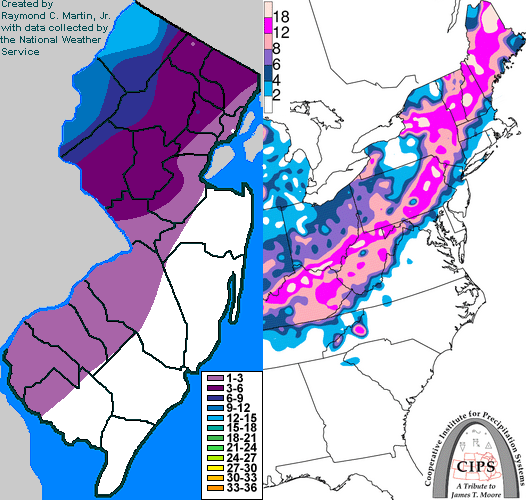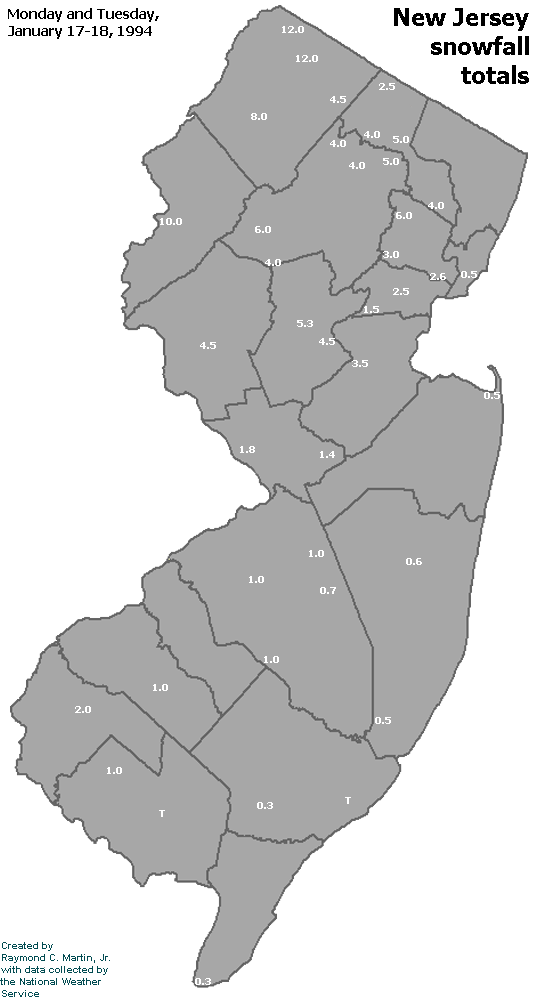

Storm description, surface observations, snowfall totals, and images courtesy of the National Climatic Data Center, the National Centers of Environmental Prediction, the Climate Prediction Center, the Hydrometeorological Prediction Center, the Mount Holly National Weather Service Office, the Upton National Weather Service Office, Rutgers University, Plymouth State University, the University of Illinois, the American Meteorological Society, Weather Graphics Technologies, AccuWeather, and the Weather Channel.
Table of Contents
Storm Summary
Regional Surface Observations
Satellite Imagery
Sea Level Pressure and 1000 to 500 Millibar Thickness Maps
850 Millibar Maps
700 Millibar Maps
500 Millibar Maps
300 Millibar Maps
200 Millibar Maps

Contoured Snowfall Totals from January 17-18, 1994
STORM DESCRIPTION
A complex storm system brought another round of snow, ice and rain to New Jersey.
Synoptic Discussion
Two areas of low pressure connected by a cold front, one in central Canada and the other near the Front Range of the Rockies, moved southeastward during the day on the 16th. They both then turned eastward during the day on the 17th, with the Canadian low passing just north of the Great Lakes and the Front Range low passing just north of the Gulf Coast. The southern low then raced northeastward on the night of the 17th, reaching New England and merging with the northern low after midnight. The combined low pressure system reached Nova Scotia by midday on the 18th.
Local Discussion
Precipitation overspread New Jersey from west to east during the morning of the 17th. In west-central and northern New Jersey, precipitation began in the form of a heavy burst of snow. Across east-central and southwestern New Jersey, it began in the form of sleet and freezing rain, while across southeastern New Jersey, it began as plain rain. A strong warm front then moved northwestward into the state, causing warm air to move in both at the surface and aloft. This caused the snow to change to sleet and freezing rain across west-central and northeastern New Jersey by early afternoon on the 17th. Further warming caused the sleet and freezing rain to change to rain across southwestern, central and northeastern New Jersey by early evening on the 17th. However, precipitation remained mainly in the form of snow and sleet across northwestern New Jersey, and continued moderate to heavy at times. As the southern low pressure system moved northeast across the state toward midnight on the 18th, cold air moved back across the state and the rain changed back to snow before ending in most areas. Snow accumulations were heaviest in the northwest, where 8 to 12 inches fell. Further south and east, 2 to 6 inches fell across northeastern and west-central New Jersey, with a coating to 2 inches across east-central and southwestern New Jersey. Ice accretion was generally 1/4 to 1/2 inch, mainly across southwestern, central and northeastern New Jersey.
New Jersey Snowfall Totals

Individual Snowfall Totals from January 17-18, 1994
Table of Contents
Storm Summary
Regional Surface Observations
Satellite Imagery
Sea Level Pressure and 1000 to 500 Millibar Thickness Maps
850 Millibar Maps
700 Millibar Maps
500 Millibar Maps
300 Millibar Maps
200 Millibar Maps
Snow storm, December 29-30, 1993
Ice storm, January 3-4, 1994
Ice storm, January 7-8, 1994
Snow and ice storm, January 17-18, 1994
Snow storm, January 25-26, 1994
Snow and ice storm, February 8-9, 1994
Snow and ice storm, February 11, 1994
Snow and ice storm, February 23-24, 1994
Snow and ice storm, March 2-3, 1994
Snow storm, March 18, 1994
Back to Ray's Winter Storm Archive
Copyright © 2012 by Raymond C Martin Jr. All rights reserved